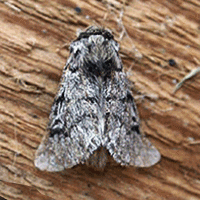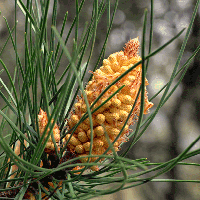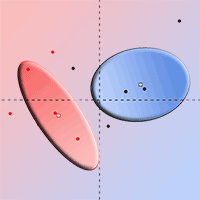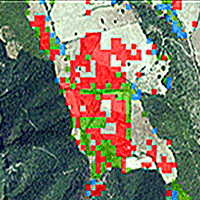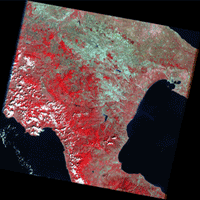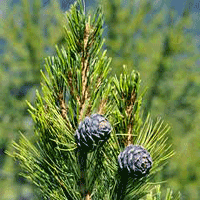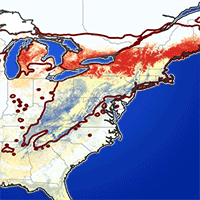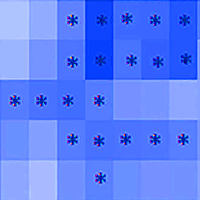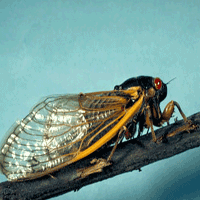
Performances of an expanding insect under elevated CO2 and snow cover in the Alps
Edoardo Petrucco-Toffolo , Andrea Battisti
iForest - Biogeosciences and Forestry, Volume 1, Issue 4, Pages 126-131 (2008)
doi: https://doi.org/10.3832/ifor0466-0010126
Published: Aug 27, 2008 - Copyright © 2008 SISEF
Research Articles
Abstract
Variations of phenology and distribution have been recently highlighted in numerous insect species and attributed to climate change, particularly the increase of temperature and atmospheric CO2. Both have been shown to have direct and indirect effects on insect species of various ecosystems, though the responses are often species-specific. The pine processionary moth, Thaumetopoea pityocampa (Lepidoptera, Notodontidae) is an important pest of conifers in the Mediterranean region, and has been recently shown to expand its altitudinal range in the Alps, including the mountain pine Pinus mugo as a novel host. We had the opportunity to transplant colonies of the pine processionary moth to a high elevation site well outside of the current range of the insect (Stillberg, Davos, Switzerland, 2180 m), where trees of the mountain pine have been grown for five years under ambient and elevated CO2 concentrations (ca. 570 ppm). The aim of the study was to evaluate the response of first instar larvae to extreme conditions of temperature and to an altered performance induced by the change of host metabolism under elevated CO2. Larval mortality and relative growth rate did not differ between host trees grown in ambient or elevated CO2. As extended snow cover may be an important mortality factor of larval colonies on the dwarf trees of mountain pine, we tested the survival of colonies transplanted at two extreme sites of Eastern Alps. The snow cover extended over more than one month proved to be an important mortality factor of larval colonies on mountain pine. We concluded that the first instar larvae of the pine processionary moth are not concerned by unusually low temperature and CO2 increase whereas they can be later strongly affected by snow accumulation. The decrease of snow cover observed in the last decades, however, may reduce such a risk.
Keywords
Climate change, Thaumetopoea pityocampa, Range expansion, Pinus
Authors’ Info
Authors’ address
Andrea Battisti
Department of Environmental Agronomy - Entomology, University of Padova, v. Università 16a, I-35020 Legnaro, PD (Italy)
Corresponding author
Paper Info
Citation
Petrucco-Toffolo E, Battisti A (2008). Performances of an expanding insect under elevated CO2 and snow cover in the Alps. iForest 1: 126-131. - doi: 10.3832/ifor0466-0010126
Paper history
Received: Apr 22, 2008
Accepted: Jul 21, 2008
First online: Aug 27, 2008
Publication Date: Aug 27, 2008
Publication Time: 1.23 months
Copyright Information
© SISEF - The Italian Society of Silviculture and Forest Ecology 2008
Open Access
This article is distributed under the terms of the Creative Commons Attribution-Non Commercial 4.0 International (https://creativecommons.org/licenses/by-nc/4.0/), which permits unrestricted use, distribution, and reproduction in any medium, provided you give appropriate credit to the original author(s) and the source, provide a link to the Creative Commons license, and indicate if changes were made.
Web Metrics
Breakdown by View Type
Article Usage
Total Article Views: 50353
(from publication date up to now)
Breakdown by View Type
HTML Page Views: 41198
Abstract Page Views: 3672
PDF Downloads: 4377
Citation/Reference Downloads: 60
XML Downloads: 1046
Web Metrics
Days since publication: 6338
Overall contacts: 50353
Avg. contacts per week: 55.61
Citation Metrics
Article Citations
Article citations are based on data periodically collected from the Clarivate Web of Science web site
(last update: Mar 2025)
Total number of cites (since 2008): 4
Average cites per year: 0.22
Publication Metrics
by Dimensions ©
Articles citing this article
List of the papers citing this article based on CrossRef Cited-by.
References
Systematisches Verzeichnis der Schmetterlinge der Wiener Gegend. Bernardi, Wien, Austria.
Gscholar
A regional impact assessment of climate and land-use change on alpine vegetation. Journal of Biogeography30: 401-417.
Gscholar
Herbivory in relation to plant nitrogen content. Annual Review of Ecology and Systematic 11: 119-161.
Gscholar
Tissue chemistry and carbon allocation in seedlings of Pinus palustris subjected to elevated atmospheric CO2 and water stress. Tree Physiology 19: 329-335.
Gscholar
Untersuchungen zur Ökologie und Technik der Hochlagenaufforstung. Forschungsergebnisse aus dem Lawinenanrissgebiet Stillberg. Schweizerische Zeitschrift für das Forstwesen 139: 735-820.
Gscholar
Technical Summary. In: “Climate change 2007: The Physical Sciences Basis. Contribution of working Group I to the Fourth Assessment Report of the Intergovernmental Panel on Climate Change” (Solomon S, Qin D, Manning M, Chen Z, Marquis M, Averyt KB, Tignor M, Miller HL eds). Cambridge University Press, Cambridge, United Kingdom and New York, NY, USA.
Gscholar

